
Industrial Control (Students guide, 1999, v1.1 )
.pdf
Experiment #3: Digital Output Signal Conditioning
In the next experiment, we will use the resistor to simulate a heating element. The fan will simulate a process disturbance that cools the heater. Our objective will be to investigate various types of control to maintain a constant temperature. Leave these circuits constructed on your Board of Education.
Before we leave this exercise, it is worth mentioning some other interfacing challenges that you may be confronted with as a designer. Consider the circuits in Figure 3.10.
Industrial Control Version 1.1 •Page 89
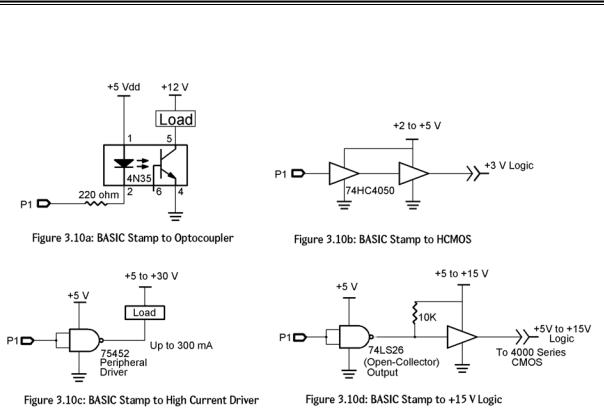
Experiment #3: Digital Output Signal Conditioning
Figure 3.10: BASIC Stamp Output Interfacing
(a)The opto-coupler can be used to interface different voltages and to electrically isolate an output from the microcontroller circuit in Figure 3.10a.
(b)Figure 3.10b can be used to interface to HCMOS or 4000-series CMOS devices. The 74HC4050 can be operated on low voltages, allowing interfacing to +3-volt logic.
(c)There is a large variety of peripheral driver chips available. The 75452 driver depicted in Figure 3.10c can sink up to 300 mA of load current. Its open-collector output allows for loads up to 30 volts.
(d)Figure 3.10d includes the 74LS26 NAND gate. This is one of a family of open-collector gates. With the 10K-ohm pull-up resistor referenced to the next circuit stage, the BASIC Stamp can be interfaced to higher-voltage CMOS circuits.
Page 90 •Industrial Control Version 1.1

Experiment #3: Digital Output Signal Conditioning
Questions and Challenges
Questions
1.Output field devices are those devices that do the ________ in a process control application.
2.Field devices usually require more power than the BASIC Stamp can deliver. List three power interface devices that can control high-power circuits and be turned on and off by the BASIC Stamp.
a.________________
b.________________
c.________________
3.The BASIC Stamp output is acting as a current sink when the load it is driving is connected between the output pin and ____________.
4.The BASIC Stamp can source __________mA per output.
5.Electronic and electromagnetic relays offer a level of protection to the microcontroller because they provide electrical _____________ between the BASIC Stamp and the power devices.
6.The input circuit of an SSR is usually an __________ ,which provides light that optically triggers an output device.
7.The current rating of an SSR should be oversized by at least _______ percent of the continuous load current demand.
8.Maximum continuous current ratings of solid-state relays usually involve applying a ____________ for proper heat dissipation.
9.______________ control involves the orderly performance of process operations.
10.When the output current from the BASIC Stamp is not sufficient to turn on the control device, an output
______________ may be used for current boosting.
Industrial Control Version 1.1 •Page 91
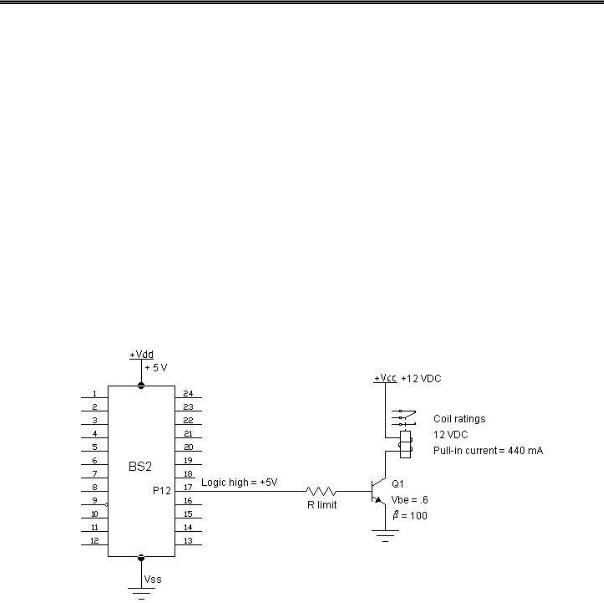
Experiment #3: Digital Output Signal Conditioning
11.If a transistor has a Beta of 150, a BS2 must deliver _______ milliamps of base current to drive a 600 mA load.
12.When a power MOSFET is saturated, its Drain to Source resistance is given as a specification termed
_______.
13.The contacts of an electromagnetic relay are shown in schematics in the “normal” position. Normal means the relay’s coil is ___________ energized.
14.The “contacts” of an AC solid-state relay are actually the main terminals of a TRIAC. These contacts would be depicted in a schematic as being normally __________.
Design It!
1.Given the figure below, solve for the maximum value of the base limiting resistor (Rlimit) that would allow the 440 mA of coil current to flow when the BASIC Stamp output Pin 12 is high.
2. To ensure deep saturation of transistor Q1, the value of Rlimit should be ____________ than this value.
Page 92 •Industrial Control Version 1.1
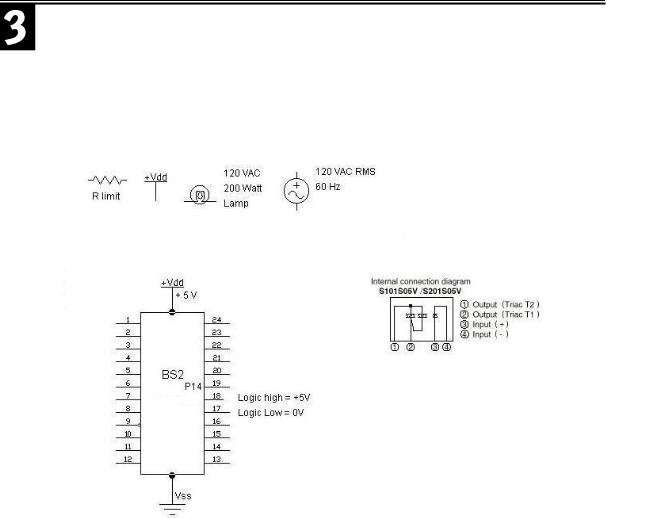
Experiment #3: Digital Output Signal Conditioning
3.The internal connection diagram of the SHARP S101S05V solid-state relay is given below. Notice that its input circuit is just an LED. The datasheet specifies that the LED has a forward voltage drop of 1.2 volts and that 15 mA through the LED will turn on the relay. Use the following components to complete the diagram for controlling the SSR with Pin 14 of the BASIC Stamp. Configure it as a current sink. Calculate the proper value of Rlimit. Draw the lamp and 120 VAC source as they would be connected to the SSR outputs.
Industrial Control Version 1.1 •Page 93
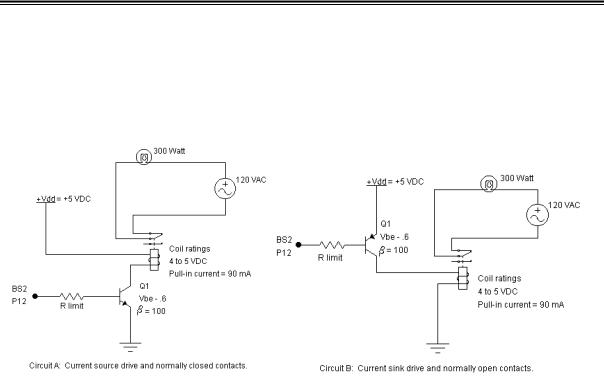
Experiment #3: Digital Output Signal Conditioning
Analyze it!
1.Consider circuits A and B below. Write a line of BASIC Stamp code that will result in turning the lamp ON for each.
Circuit A _____________________________. |
Circuit B __________________________. |
Page 94 •Industrial Control Version 1.1
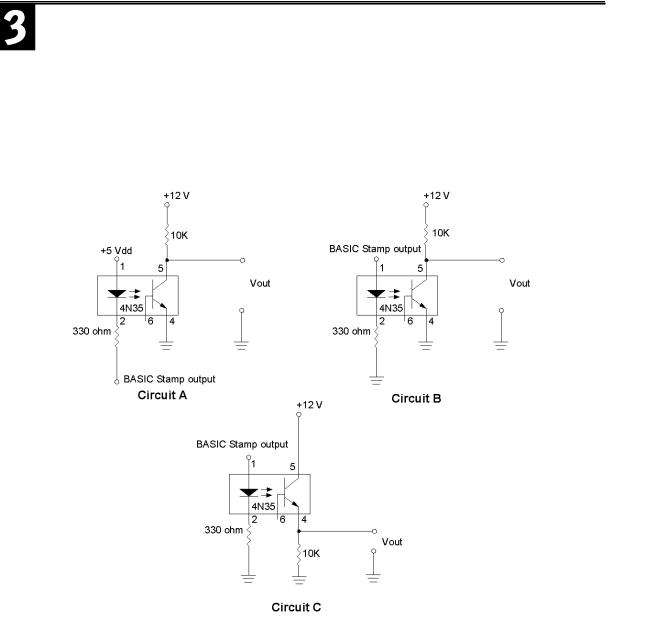
Experiment #3: Digital Output Signal Conditioning
2.Study the three figures shown below. Would you write a logic High or a logic Low to the BASIC Stamp output to yield a 12-volt Vout value?
Circuit A _______________
Circuit B _______________
Circuit C _______________
Industrial Control Version 1.1 •Page 95

Experiment #3: Digital Output Signal Conditioning
Program it!
1.Given the input and outputs pictured back in Figure 3.3b, write a sequential program that will do the following:
Momentarily pressing P1 will cause P3 to turn ON for three seconds and then go OFF. Pressing P1 a second time will cause P4 to come ON for three seconds and then go OFF. When P4 goes OFF, P5 will come ON until P2 is pressed.
2.Try this one. Using the same I/O, write a program that will do the following:
Press and hold P1 and P3 goes ON. Holding P1 and pressing P2 causes P3 to go OFF and P4 to come ON. Releasing P1 while continuing to hold P2 turns OFF P4 and ON P5. And lastly, releasing P2 will turn all three outputs ON for three seconds, then all OFF, and the process is set to repeat.
Page 96 •Industrial Control Version 1.1

Experiment #4: Continuous Process Control
Continuous process control involves maintaining desired process conditions. Heating or cooling objects to a certain temperature, holding a constant pressure in a steam pipe, or setting a flow rate of material into a vat in order maintain a constant liquid level, are examples of continuous process control. The condition we desire to control is termed the
“process variable.” Temperature, pressure, flow rate, and liquid level are the process variables in these examples. Industrial output devices are the control elements. Motors, valves, heaters, pumps, and solenoids are examples of devices used to control the energy determining the outcome of the processes.
The control action taken is based on the dynamic relationship between the output device’s setting and its effect on the process. Generally speaking, process control can be classified into two types: open loop and closed-loop. Closed-loop control involves determining the output device’s setting based on measurement and evaluation during the process. In open-loop control, no automatic check is made to see whether corrective action is necessary.
A simple example of open-loop control would be cooling your bedroom on a hot summer evening. Your choices are using a window fan or an air conditioner. The window fan is a device that you set – low, medium, or high speed – based on your evaluation of what the situation needs for control. This evaluation involves an understanding of what the cause-and-effect relationship is of your speed setting vs. the room conditions. There is also an element of prediction involved. Once you make the setting decision, you are in for the night. You are setting up an open-loop control system. If your evaluations are correct, you will have a great night’s sleep. If they are not, you may wake up shivering and cold or sweaty and hot! On the other hand, a room air conditioner allows you to set a certain desired temperature. A thermostat continuously compares the desired temperature with a measurement of actual room temperature. When room temperature is over the desired setpoint, the air conditioner is turned on. As the room cools below the setpoint, the air conditioner is turned off. As the night goes on and the outside temperature cools down, this closed-loop system will automatically spend less time on than off. This is an example of closed-loop feedback control, because the action is taken based on measurement of room temperature.
Which is better? Arguably, some people prefer air conditioning to a fan, but others do not. If the objective is to maintain a comfortable sleeping temperature, they both have their advantages. In terms of industrial control, the lower cost and simplicity of setting the window fan in an open-loop mode is very attractive. On the other hand, the automatic control of the closed-loop air conditioner ensures a more consistent bedroom temperature as the outside temperature changes.
Industrial Control Version 1.1 •Page 97
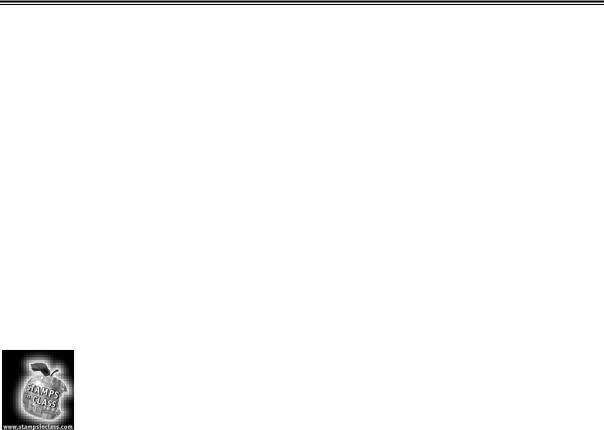
Experiment #4: Continuous Process Control
Determining the best control action for an application and designing the system to provide this action is what the field of process control engineering is all about.
Microcontrollers have proven to be a dependable, cost-effective means of adding a level of sophistication to the simplest of control schemes. The next three exercises will focus on the characteristics of various methods of continuous control. We will develop an environment in which we can model process control, get process variable data into the BASIC Stamp, and study open-loop control principles. The first two exercises will take a little time and effort, but will be worthwhile, because the setup and circuitry will be used again for Experiments #5 and #6.
Temperature is by far the most common process variable that you will encounter. From controlling the temperature of molten metal in a foundry to controlling liquid nitrogen in a cryogenics lab, the measurement, evaluation, and control of temperature are critical to industry. The objective of this exercise is to show principles of microcontroller-based process control and enlighten you about interfacing the controller to real-world I/O devices. The exercises are restricted to circuits that fit on the Board of Education and to output devices that can be driven by its 9-volt, 300-mA power supply. As you monitor and control the temperature of a small environment, realize that, through proper signal conditioning, the applications for which you can apply the BASIC Stamp are limitless.
Exercises
Exercise #1: Closed-Loop, On-Off Control
To set up our small environment, you will need the following parts:
•35 mm plastic film container
•47-ohm, half-watt carbon resistor with leads
•LM34DZ integrated circuit temperature sensor with leads
•Electrical tape
Page 98 •Industrial Control Version 1.1
